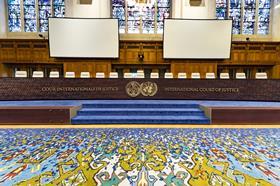Heavyweight jurists continue to trade conflicting opinions over whether arms exports to Israel should cease because the UK’s current policy allegedly breaches international law.

UK Lawyers for Israel has today issued a detailed riposte to the most recent statement from an initiative of hundreds of former judges, lawyers and legal academics who have called on the prime minister to impose sanctions. On Tuesday the latter group published a detailed rebuttal in the Gazette of claims from UKLFI that their demands are based on a mistaken reading of the International Court of Justice (ICJ) ruling on genocide.
Today's statement from UKLFI says this rebuttal 'fundamentally misinterprets the necessary conditions for the indication of provisional measures under Article 41 of the International Court of Justice statute'.
More than 1000 former judges, lawyers and legal academics signed the first open letter, of 3 April, to the prime minister calling for sanctions. They included Lady Hale, former president of the Supreme Court, former Supreme Court justices lords Sumption and Wilson, and former Court of Appeal judges Sir Richard Aikens, Sir Anthony Hooper, Sir Alan Moses and Sir Stephen Sedley. All seven also endorsed the initiative's rebuttal of UKLFI's first letter.
UKLFI's first letter had 1,300 signatories, including former Supreme Court Judges lords Collins, Dyson and Woolf, and other prominent British lawyers including lords Macdonald, Pannick, Grabiner, Wolfson and Banner.
Today's statement from the the UKLFI follows below.
UKLFI’s Response to Israel Critique
1. On 9 April 2024, the Law Gazette published a response (the “Third Letter”)1 to the 5 April 2024 letter to the Prime Minister (the “Second Letter”),2 signed by over 1,300 former Judges, lawyers and legal academics, including former Supreme Court Judges Lord Collins, Lord Dyson and Lord Woolf, as well as numerous other leading British lawyers such as Lord Macdonald, Lord Pannick, Lord Grabiner, Lord Wolfson and Lord Banner. The Second Letter was organised by UK Lawyers for Israel (UKLFI) but most of the signatories were not members of UKLFI.
2. The Second Letter explained why the original letter on Gaza (the “First Letter”),3 claiming that the UK had an obligation under the Genocide Convention to cease arms exports to Israel, amongst other claims, was founded on an erroneous interpretation of the applicable law and the Order of the International Court of Justice (the “Court” or the “ICJ”) dated 26 January 2024 (the “Provisional Measures Order” or “the Order”), as well as other inaccuracies and omissions.
“Plausible risk of genocide”
3. The Third Letter claims that the analysis of the Provisional Measures Order as set out in the Second Letter is wrong and goes on to detail six alleged flaws of that analysis. In doing so, it fundamentally misinterprets the necessary conditions for the indication of provisional measures under Article 41 of the Court’s Statute.
4. The requirement of a prima facie case does not derive from Article 41, which provides only that “[t]he Court shall have the power to indicate, if it considers that circumstances so require, any provisional measures which ought to be taken to preserve the respective rights of either party.”4 Rather, it is a condition deriving from the Court’s interpretation of Article 41 as held in its past cases, and was addressed for the first time in the Great Belt case.5 The Court found in that case that a prima facie case existed because the right claimed by Finland (namely the right of passage through the Great Belt) existed and only the extent of that right was disputed, so that there was a case to decide upon.6 In other words, the establishment of a prima facie case, for the purpose of indicating provisional measures, rested on a finding that the right claimed existed – not that a violation of that right had occurred.
5. The “plausibility test” was first introduced by the Court as a new parameter for determining the existence of a prima face case in the cases that followed the Separate Opinion of Judge Abraham in the Pulp Mills case. In his opinion, he stated that because provisional measures orders gave rise to obligations on sovereign states, the Court needed to satisfy itself in the first instance that there was a “plausible case for the existence of the right” claimed by the applicant.7 Thus, in the Obligation to Prosecute or Extradite case that followed, the Court found the rights asserted by Belgium to be plausible because they were “grounded in a possible interpretation of the Convention Against Torture”.8 Then, in the Certain Activities in the Border Area case, the Court clarified that what was relevant to establish “plausibility” was only the plausibility of the claim as raised by the requesting party – and not the plausibility of any arguments to the contrary. As succinctly summarised in the chapter on Article 41 in The Statute of the International Court of Justice (2nd Edition): A Commentary:
“In that case the disputed right concerned the sovereignty claimed by both parties over the same territory. The Court found that the ‘title to sovereignty claimed by Costa Rica [the Applicant] … is plausible’ and then made it clear that it was ‘not called upon to rule on the plausibility of the title to sovereignty over the disputed territory advanced by Nicaragua [the defendant]’. While this statement may seem at a first glance not to be in accordance with Art. 41 of the Statute which concerns the preservation of ‘the respective rights of either party’, it nevertheless is justified because what is at stake in this context is exclusively whether the claim of the applicant is one being susceptible of a legal decision.9
6. Put plainly, the existence of a prima facie case rests on whether there is a plausible right claimed by the applicant, and the existence of a plausible right rests on whether the claim of the applicant is one that is susceptible of a legal decision – not whether a violation of a right has been plausibly established.
7. Reading into the Provisional Measures Order any finding as to the merits of the case, including a finding that there is a plausible risk that Israel is committing genocide against the Palestinians in Gaza, disregards the Court’s clear and unambiguous statement in paragraph 30 (repeated at paragraph 62) that it is:
“… not required to ascertain whether any violations of Israel’s obligations under the Genocide Convention have occurred. Such a finding could be made by the Court only at the stage of the examination of the merits of the present case. As already noted (see paragraph 20 above) at the stage of making an order on a request for the indication of provisional measures, the court's task is to establish whether the acts and omissions complained of by the applicant appear to be capable of falling within the provisions of the Genocide Convention... In the Court’s view, at least some of the acts and omissions alleged by South Africa to have been committed by Israel in Gaza appear to be capable of falling within the provisions of the Convention.”
8. The last sentence of paragraph 30 does not read, as the First and Third Letter would have it, that at least some of the acts and omissions alleged by South Africa to have been committed by Israel in Gaza appear to be “plausible” or “likely” or “arguable” or “at risk of happening” or anything which could constitute a finding, even a prima facie one, that they are or might be true. In the Court’s view they appear merely “capable of falling within the provisions of the Convention.”
9. The Third Letter reads into paragraph 74 of the Provisional Measures Order a finding of “plausible risk of genocide” based on the “Court’s unambiguous conclusion… that there was a ‘real and imminent risk that irreparable prejudice will be caused to the rights found by the Court to be plausible’”.10 However, that paragraph deals with urgency and their interpretation reveals a fundamental misunderstanding of the necessary conditions for indicating provisional measures at the ICJ. The requirement of urgency is crucial for the justification of any interim protection measures at the ICJ, and urgency is closely linked to the requirement of irreparable prejudice. If there is no imminent irreparable prejudice, then there is no urgency.11 However, where the Court has before it a case, the subject matter of which concerns human life, particularly on a large scale, the risk of irreparable prejudice is always imminent.12 Thus, “the condition of urgency [has been] found to exist in all cases concerning genocide or ethnic cleansing”.13
10. Contrary to what is claimed in the Third Letter, a finding that irreparable prejudice may be caused to the rights claimed by South Africa with respect to the Palestinians in Gaza says nothing about the plausibility that those rights have been violated or that they are at risk of being violated. It means only that the rights claimed pertain to the protection of human life, for which the risk of irreparable damage is inherent. Simply put, if in the future, the Court were to find on the merits that there had been a violation of the Genocide Convention, by then it would be too late. This, and only this, is what is required by the condition of urgency.
11. If, as the Third Letter suggests, the Court had found that there was a plausible risk that Israel was committing genocide against the Palestinians in Gaza, such as would have rendered the UK in violation of its obligations under the Genocide Convention if it were to continue to supply arms to Israel, one might have expected the Court to order Israel to cease its military operation in Gaza, as South Africa indeed requested the Court to do. At the very least, one would have expected the Court actually to use the phrase “plausible risk of genocide” in its Order if that was what it meant to say. By suggesting that the Court did not say what it actually meant to say, it is the authors of the Third Letter who appear to be engaged in “wordplay”, rather than the authors of the Second Letter, as they assert.
Casualty statistics
12. There are two other aspects of the Third Letter which merit a response. The first is the authors’ continued reliance on statistics of Palestinian casualties issued by the Hamas- run Gaza Health Ministry. The authors claim their figures are derived from “UN briefings” but the UN Office for the Coordination of Humanitarian Affairs (OCHA), which distributes these figures, acknowledges that it gets them from the Gaza Health Ministry; and notes that “[i]t is nearly impossible at the moment to provide any UN verification on a day-to-day basis."14
13. The authors of the Third Letter also say that these figures “have been assessed by Human Rights Watch as consistent with its own independent investigations.”15 The source cited by the Third Letter to support this is an article dated 27 October 2023 – 20 days after the Hamas attack on Israel – in which a representative from Human Rights Watch states that he has seen “no evidence that the numbers were being manipulated”.16
14. Since then, it has been claimed that the methods used by the Gaza Health Ministry to compile the figures have been changed in a way that facilitates manipulation,17 and there have been at least five statistical analyses, carried out by statisticians, data scientists, biomathematicians and economists from the Wharton School of the University of Pennsylvania, the Royal Melbourne Institute of Technology, the Washington Institute for Near East Policy, and others, each of which have found that the casualty figures do not add up and have very likely been fabricated or manipulated. The Second Letter included references to each of these analyses.18 Regrettably, the Third Letter did not address any of them.
15. Moreover, as the Second Letter also pointed out, even if the figures produced by the Hamas-run Gaza Health Ministry were to be accepted, they include Hamas combatants as well as Palestinian civilians killed by Hamas. In fact, on the available evidence, the ratio of Palestinian civilians to combatants killed is far lower than usual in urban armed conflict, testifying to the extraordinary efforts made by the Israel Defence Forces (IDF) to avoid civilian casualties. The authors of the Third Letter misattribute19 and dispute the IDF’s assessment of the number of Hamas and other combatants killed. A sceptical approach to all casualty figures issued during a war might well be justified. Applied selectively only to one side’s claims cannot engender confidence in the conclusions.
Israel’s right to self-defence
16. The final point to mention is the Third Letter’s belated reference to the question of Israel’s self-defence. The First Letter set out an account of “the facts” on which its conclusions and unsolicited advice to the British Government were based. As pointed out in the Second Letter, this account of the facts made no mention of Israel’s right of self-defence, or indeed of any fact which might have thrown doubt on the “facts” cited, or set them in context, or explained why they ought to be trusted in the face of well- founded criticism.
17. The Third Letter deals with the omission firstly by doubting that Israel has any right of self-defence. The authors suggest that the right of self-defence only applies in relation to an armed attack by a foreign State. This premise is founded on the questionable view expressed in paragraph 139 of the ICJ’s non-binding Advisory Opinion in the so-called “Wall” case,20 that Article 51 of the UN Charter only applies to an attack by a State against another State.21 But the Court went on to say in paragraph 141 of the same Opinion that Israel “has the right, and indeed the duty, to respond in order to protect the life of its citizens … in conformity with applicable international law”.
18. Israel’s current military action is in response to an armed attack launched by the terrorist organisation in actual totalitarian control of Gaza, supported, financed, trained and encouraged by the foreign state of Iran. The barbaric attack included the murder of over 750 civilians, as well as multiple rapes, torture and kidnapping. As observed in the Second Letter, Hamas has publicly vowed that it will repeat the atrocities of 7 October again and again. If the authors of the First and Third Letters believe that international law does not permit a state to defend itself against such an attack and the threat of further, unending, like attacks, then it would be very surprising if the British government paid any attention to their opinions.
19. The Third Letter claims, secondly, that even if Israel has a right to self-defence in relation to the Gaza Strip, it has not exercised this right proportionately. However, without reliable figures for the Palestinian civilian and combatant casualties, the “facts” set out in the First Letter are not indicative of a “grossly disproportionate deployment of force in Gaza”,22 as the Third Letter claims.
UK Lawyers for Israel, Aldgate Tower, 2 Leman Street, London E1W 9US
Email: info@uklfi.com Website: www.uklfi.com
Patrons: Lord Carlile CBE KC, Lady Cosgrove CBE KC, Baroness Deech DBE KC, Lord Dyson PC, Lord Grabiner KC, Stephen Hockman KC, Lord Howard CH PC KC, Sir Ivan Lawrence KC, Lord Pannick KC, Professor Richard Susskind OBE FRSE KC
UK Lawyers for Israel is the operating name of UKLFI Limited (Company no. 07396781)
11 April 2024
1 https://www.lawgazette.co.uk/news/exclusive-former-sc-justices-and-court-of-appeal-judges-rebut-uk-lawyers- for-israel-critique/5119319.article
2 https://mailchi.mp/uklfi/lawyers-letter
3 https://lawyersletter.uk/wp-content/uploads/2024/04/Gaza-letter-FIN-3-April.pdf
4 ICJ Statute, Article 41(1).
5 Passage through the Great Belt (Finland v. Denmark), Provisional Measures, Order of 29 July 1991 [1991] ICJ Rep. 12, para. 21.
6 K. Oellers-Frahm, ‘Part Three Statute of the International Court of Justice, Ch.III Procedure, Article 41, C Conditions for the Indication of Provisional Measures’ in A. Zimmermann et al., The Statute of the International Court of Justice: A Commentary (2nd edn, OUP 2012), para. 36.
7 Pulp Mills on the River Uruguay (Argentina v. Uruguay), Provisional Measures, Order of 13 July 2006 [2006] ICJ Rep 113, Separate Opinion of Judge Abraham, para. 11.
8 Questions relating to the Obligation to Prosecute or Extradite (Belgium v. Senegal), Provisional Measures, Order of 28 May 2009 [2009] ICJ Rep. 139, para. 60.
9 Oellers-Frahm (n. 6), para. 37.
10 Third Letter, para. 3.
11 Oellers-Frahm (n. 6), para. 44.
12 Oellers-Frahm (n. 6), para. 44.
13 Oellers-Frahm (n. 6), para. 44, citing to
14 Despite Biden's doubts, humanitarian agencies consider Gaza toll reliable | Reuters
15 Third Letter, para. 9.
16 https://www.theguardian.com/world/2023/oct/26/can-we-trust-casualty-figures-from-the-hamas-run-gaza- health-ministry
17 https://www.washingtoninstitute.org/policy-analysis/gaza-fatality-data-has-become-completely-unreliable; https://www.washingtoninstitute.org/policy-analysis/how-hamas-manipulates-gaza-fatality-numbers- examining-male-undercount-and-other
18 Since then another analysis has been published, providing further evidence of manipulation: https://twitter.com/MarkZlochin/status/1777057066600763852
19 The Third Letter suggests that the figure of 13,000 terrorists relied on in the Second Letter is based upon an assertion made by PM Benjamin Netanyahu. In fact, it is an official IDF figure.
20 ICJ Reports 2004 p136; https://www.icj-cij.org/sites/default/files/case-related/131/131-20040709-ADV-01-00- EN.pdf
21 It is also arguable that international law on this point has developed since then: see the (UK) Attorney General’s Speech at the International Institute for Strategic Studies, The modern law of self-defence, 11/1/2017 https://www.gov.uk/government/speeches/attorney-generals-speech-at-the-international-institute-for-strategic- studies
22 Third Letter, para. 8.

























